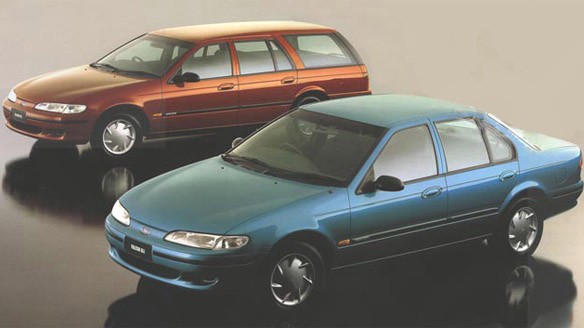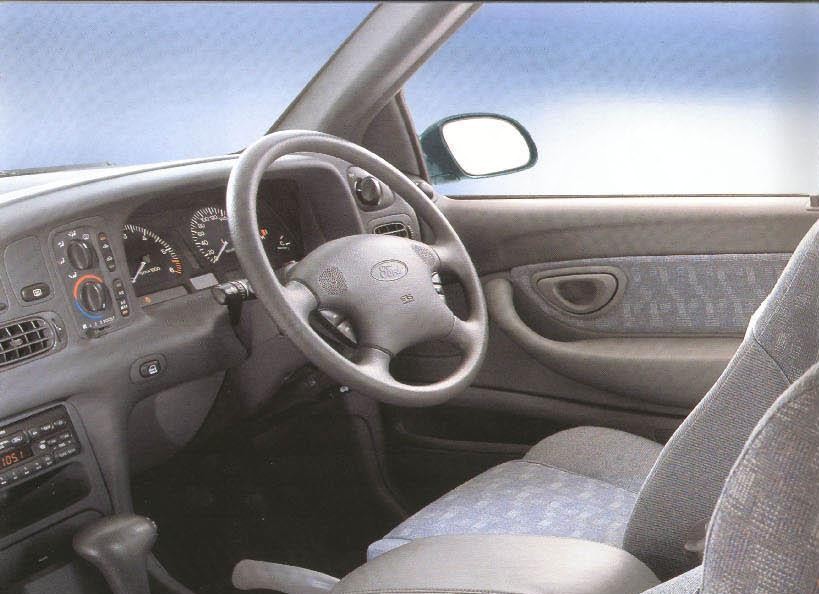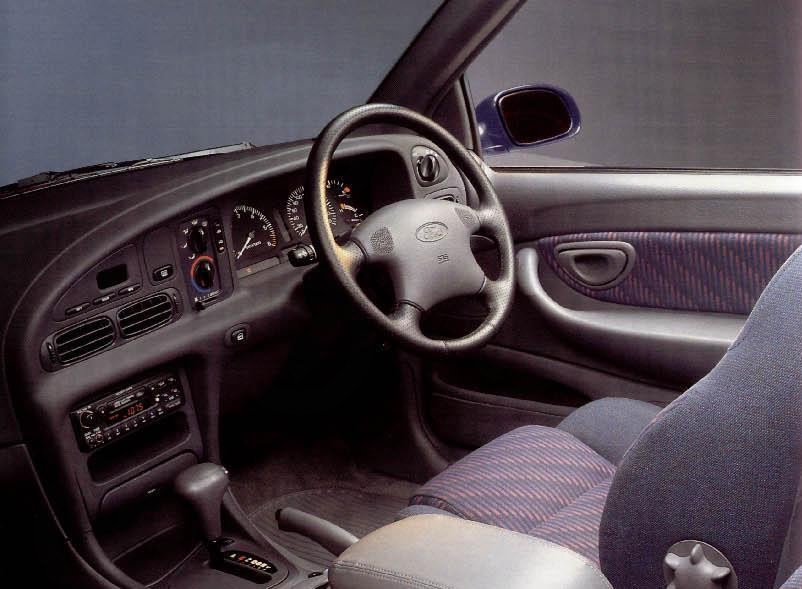
- Responsive engines
- Spacious interior
- Folding rear seats add to cargo capacity
- Good visibility
- Comfortable ride…
- … but suspension design can cause roll-oversteer
- Vague steering
- Poor standard of fit and finish
- Inadequate air conditioning system
- Basic live rear axle suspension
Review: Ford EF.I Falcon (1994-95)
Overview
Released in September 1994, the Ford EF Series (EF.I) Falcon was available as sedan or wagon. Manufactured in Campbellfield, Victoria, the rear-wheel drive Falcon was available with either a 4.0-litre inline six-cylinder petrol engine or a 4.9-litre V8 petrol engines. Furthermore, the EF Falcon range consisted of GLi, Futura, XR6 and XR8 variants.
Engines
Of the engines.
- the 4.0-litre inline six cylinder engine had cast iron block, an alloy cylinder head, a single overhead camshaft (SOHC), two valves per cylinder and a compression ratio of 9.3:1; and,
- the 4.9-litre pushrod V8 engine had a cast iron block and cylinder head, two valves per cylinder and a compression ratio of 9.0:1.
Both engines were available with four-speed automatic and five-speed manual transmissions.
Dimensions and suspension
The EF Falcon sedan was 4906 mm long, 1861 mm wide, 1453 mm tall and had a 2791 mm long wheelbase. The wagon models, however, were 136 mm longer (at 5042 mm), 5 mm narrower (1856 mm), 76 mm taller (1529 mm) and had 132 mm longer wheelbases (2923 mm). Furthermore, the EF Falcon had Short Long Arm (SLA) front suspension and sedans had a live rear axle with four trailing arms and Watts linkages; wagons, however, had a live rear axle with leaf springs.
Developments
Compared to the ED Falcon, the EF Falcon could be identified by its more rounded body panels and elongated headlights. Inside, cup holders were fitted as standard and there was a new floor-mounted hand brake. The EF Falcon was also fitted with new a crankshaft and hydraulic engine mounts for greater refinement.
| Body | Variant | Engine | Trans. | Peak power | Peak torque |
|---|---|---|---|---|---|
| Sedan | GLi, Futura |
4.0-litre petrol I6 | 4sp auto, 5sp man. |
157 kW at 4900 rpm | 357 Nm at 3000 rpm |
| 4.9-litre petrol V8 | 4sp auto | 165 kW at 4500 rpm | 388 Nm at 3000 rpm | ||
| XR6 | 4.0-litre petrol I6 | 4sp auto, 5sp man. |
164 kW at 5000 rpm | 366 Nm at 3150 rpm | |
| XR8 | 4.9-litre petrol V8 | 4sp auto, 5sp man. |
170 kW at 4750 rpm | 398 Nm at 3000 rpm | |
| Wagon | GLi, Futura |
4.0-litre petrol I6 | 4sp auto, 5sp man. |
157 kW at 4900 rpm | 357 Nm at 3000 rpm |
| GLi | 4.9-litre petrol V8 | 4sp auto | 165 kW at 4500 rpm | 388 Nm at 300 rpm | |
| XR6 | 4.0-litre petrol I6 | 4sp auto, 5sp man. |
164 kW at 5000 rpm | 366 Nm at 3150 rpm |
Safety equipment
Standard safety equipment included a driver’s airbag and anti-submarining front seat pans; the Futura, XR6 and XR8 variants were also fitted with ABS.
Brakes
The standard braking pacakge for the EF Falcon consisted of 287 mm ventilated front brake discs and 299 mm solid rear discs.
Features: Falcon GLi, Futura, XR6 and XR8
Standard features for the Falcon GLi included a four speaker sound system with radio and cassette player, 60/40 split and folding rear seats, remote central locking, power mirrors, a rake and reach adjustable steering wheel, height adjustable driver’s seat and immobiliser. The Futura was further equipped with a six speaker sound system, cruise control and front power windows.
Beyond this, the Falcon XR6 and Falcon XR8 added 15-inch five-double spoke alloy wheels with sport suspension, contoured sports seats (with ‘Grand Prix’ cloth trim), a leather-wrapped steering wheel and rear spoiler. The XR6 and XR8 were also fitted with a limited slip differential.
Review: Ford EF.II Falcon (1995-96)
Overview
Released in October 1995, the EF Series II (EF.II) Falcon introduced a revised range as the XR6 wagon was discontinued and reduced cabin noise with the introduction of neoprene rubber insulation. The front suspension was also revised for more stable cornering by raising the position of the front ball joint, reducing toe-in, fitting a thicker anti-roll bar and firmer lower wishbone bushes.
Visually, the EF.II Falcon could be identified by its body-coloured B-pillar and convex passenger-side door mirror. Inside, there was reduced front seat padding for a lower driving position.
| Body | Variant | Engine | Trans. | Peak power | Peak torque |
|---|---|---|---|---|---|
| Sedan | GLi, Futura |
4.0-litre petrol I6 | 4sp auto, 5sp man. |
157 kW at 4900 rpm | 357 Nm at 3000 rpm |
| 4.9-litre petrol V8 | 4sp auto | 165 kW at 4750 rpm | 388 Nm at 3000 rpm | ||
| XR6 | 4.0-litre petrol I6 | 4sp auto, 5sp man. |
164 kW at 5000 rpm | 366 Nm at 3150 rpm | |
| XR8 | 4.9-litre petrol V8 | 4sp auto, 5sp man. |
170 kW at 4750 rpm | 398 Nm at 3000 rpm | |
| Wagon | GLi | 4.0-litre petrol I6 | 4sp auto, 5sp man. |
157 kW at 4900 rpm | 357 Nm at 3000 rpm |
| 4.9-litre petrol V8 | 4sp auto | 165 kW at 4750 rpm | 388 Nm at 300 rpm | ||
| Futura | 4.0-litre petrol I6 | 4sp auto | 157 kW at 4900 rpm | 357 Nm at 3000 rpm |
Safety equipment
Compared to its EF.I predecessor, standard safety equipment was unchanged although a front passenger airbag – which also provided protection for the middle passenger for models with front bench seats – was available as an option.
Features
Standard features, however, were largely unchanged.
1995 Ford Falcon GLi Classic and Futura Classic
In November 1995, Classic editions of the GLi and Futura variants were released. Compared to the standard GLi and Futura, the Classic editions added 15-inch alloy wheels and air conditioning.
Related links





